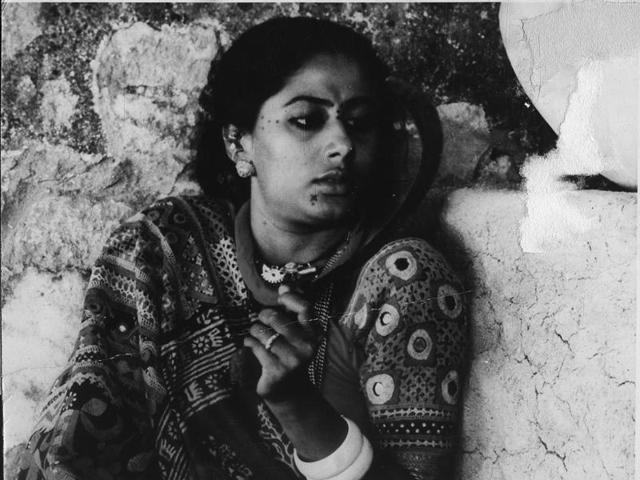Maithili Rao’s book on Smita Patil gives marvellous insights
Rao doesn’t make this a plain chronological narration of Smita’s life story. A senior critic and columnist, she has an immense understanding of cinema.
Smita Patil: A Brief Incandescence

Maithili Rao
HarperCollins
Rs 450; PP 347
Some 70 pages into her biography of Smita Patil, author Maithili Rao gets into granular detail about the actor’s style: “She was not a Method actor. She followed her instinct and acted from the gut, putting herself entirely in the director’s hands. Her greatest asset was her intensity. Intensity became her. Intensity defined her.”
December 13 marks 29 years since Smita left us. While her sudden demise came as a shock to thousands of fans, her performances still stay in our hearts. Rao’s biography, entitled ‘Smita Patil - A Brief Incandescence’, not only captures her acting career in detail but also provides some wonderful insights into her personality and approach to life.
Rao does not delve into her controversial marriage. In the introduction she explains: “I made several attempts to get in touch with Raj Babbar but without success… I would neither use confidences shared by Smita’s friends, nor give credence to second-hand gossip and lurid speculation.”

Most admirably, Rao doesn’t make this a plain chronological narration of Smita’s life story. A senior critic and columnist, she has an immense understanding of cinema, which comes across through in her strong research and analysis. Each of Smita’s major films is reviewed in minute detail, right from the storylines and style of the directors to the costumes she wore and the way shots were captured. On another level, the book works almost as a textbook on how parallel cinema of the 1970s and 1980s functioned, and the individual approach of filmmakers like Shyam Benegal, Jabbar Patel, Govind Nihalani, Mahesh Bhatt, and Muzaffar Ali.
Appropriately, the foreword is by Benegal, who single-handedly established the Smita phenomenon with ‘Charandas Chor’, ‘Nishant’ and ‘Manthan’, before directing her in ‘Bhumika’, ‘Kondura’ and ‘Mandi’. He talks about her wide range of interests, and how directors would worry that these would distract her from her roles. “This never happened because she had that rare ability to switch on and off at will. The moment she stepped in front of the camera lens, she was totally focused,” he says.
The first two chapters talk of Smita’s Pune roots and her reluctant shift to Bombay. The daughter of Vidya and politician-social activist Shivajirao Patil, Smita was the second among three sisters. “Right from childhood, Smita was the emotional one while the other two children were more practical,” says Rao, who later describes how, though good at studies, she later became more interested in “masti and gaali galot with the boys.”

Smita’s first claim to fame was as a Marathi newsreader on Doordarshan. She made her acting debut in Arun Khopkar’s diploma film ‘Teevra Madhyam’, where she plays a college lecturer deeply devoted to classical music. Rao explores the sheer variety of roles she later enacted. In the chapter ‘Smita Patil and her Dasavatars’, she thoroughly reviews her selection of 10 best major performances - ‘Manthan’ (Benegal), ‘Jait Re Jait’ (Jabbar Patel), ‘Bhumika’ (Benegal), ‘Akaler Sandhane’ (Mrinal Sen), ‘Chakra’ (Rabindra Dharmaraj), ‘Umbartha’ (Patel), ‘Arth’(Mahesh Bhatt), ‘Bazaar’ (Sagar Sarhadi), ‘Tarang’ (Kumar Shahani) and ‘Aakhir Kyon’ (J Om Prakash). In the next chapter ‘Ensemble Excellence’, Rao talks of ensemble films like ‘Bhavni Bhavai’ (Ketan Mehta), ‘Albert Pinto Ko Gussa Kyon Aata Hai’ (Saeed Mirza), ‘Mandi’ (Benegal) and ‘Mirch Masala’ (Ketan Mehta). Here, Smita did not have a leading role but was one among a stellar cast that included Naseeruddin Shah, Shabana Azmi, Om Puri, Kulbhushan Kharbanda and Neena Gupta. On Smita’s entry into commercial cinema, the author questions her utter lack of discrimination while signing films like ‘Badle Ki Aag’, ‘Haadsaa’ and ‘Kaanch Ki Deewaar’. However, over a period, she admires the way the actor balanced the two. “Smita had gained the assurance to straddle the two worlds without losing an iota of her professional and artistic commitment to either,” she says. Rao narrates an interesting anecdote about the rain-drenched raunchy song ‘Aaj rapat jaaye’ from Prakash Mehra’s ‘Namak Halaal’. “Smita is reported to have wept inconsolably during the filming of the song. She knew what she had signed up but did not think it would be this demeaning,” she says.
Read: Smita Patil felt awkward about films she did with me, says Amitabh Bachchan
Besides the film factor, Rao brings out many wonderful facets of Smita’s personality. Special mention is made of her caring and warm nature. Whether one knew her personally or just admired her acting skills, Smita was very special. Her charisma has in fact been summed up in various ways in the introduction itself. “She was Indian cinema’s Everywoman.” “Smita’s face fascinates; she has an earthy look that could belong to any part of India.” “She was indubitably the Pole Star of parallel cinema.” Her death left a pall of gloom among well-wishers. Satyajit Ray announced: “There is really no one to replace her.” The legend lives on.
Narendra Kusnur is a music critic. He lives in Mumbai.





